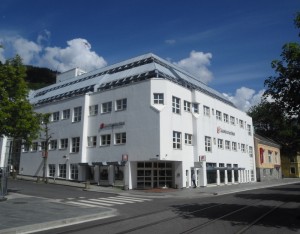Sparebanken Vest in Eu500m covered as market weakens
Sep 18th, 2015
Sparebanken Vest found conditions challenging when executing a Eu500m five year covered bond on Tuesday and paid more than expected, according to an official at the bank, but he said the issuer moved early as it is not clear the market will improve in the coming weeks.
 Bankers meanwhile bankers expect a well-stocked pipeline to weigh against the benefits of a Fed decision yesterday (Thursday) to hold off on a rate hike.
Bankers meanwhile bankers expect a well-stocked pipeline to weigh against the benefits of a Fed decision yesterday (Thursday) to hold off on a rate hike.
Sparebanken Vest Boligkreditt’s deal arrived in a market weaker than issuers had enjoyed at the start of the month, with bankers citing heavy supply in the first half of September and uncertainty regarding the US Federal Reserve meeting yesterday (Thursday) as decreasing investor appetite. A Eu1bn 10 year social covered bond from Spain’s Kutxabank on Monday attracted Eu1.15bn of orders while a Eu1bn seven year Bank of Montreal benchmark was only just covered.
Leads Deutsche, HSBC, ING and Nordea launched Sparebanken Vest’s Eu500m no-grow five year issue on Tuesday morning with initial price thoughts of 8bp over mid-swaps. This level was maintained for guidance, before the re-offer was fixed at 7bp.
“We are quite happy it was possible to land a deal on Tuesday, as the market is different from how it was just a few weeks ago,” said Egil Mokleiv, managing director at Sparebanken Vest. “We are glad we could have an oversubscription even on a day when the market was not in its best shape.”
Tuesday’s only other trade, a Eu500m eight year from Deutsche Kreditbank, was also priced 1bp inside IPTs, while generating books of Eu550m. Sparebanken Vest’s books closed at above Eu650m, making it one of the week’s more oversubscribed deals. On Wednesday, a Eu500m issue from Crédit Mutuel Arkéa found sufficient traction to tighten its spread slightly further – from the low single-digits over mid-swaps to 1bp – and attracted Eu550m of demand.
As anticipated, no new issuance was brought forward on Thursday as market participants awaited the Fed announcement and the primary market remained silent this (Friday) morning as the decision not to raise interest rates was digested. Syndicate officials noted that European equities were down 1% in early trade with credit indices following suit, senior 1.5bp wider and sub around 3bp wider.
“On the primary market side, we’re back to the status quo,” said Robert Chambers, FIG syndicate manager at Crédit Agricole CIB. “People are still looking towards a Fed rate hike this year, whether it is at the next meeting in October or further down the road, so in euro markets we’re still in a similar situation to where we were at the start of the week.”
Syndicate officials said the Fed’s decision and the brief break in issuance could help rebuild demand, but said investors would likely still be selective next week, with six issuers having publicly announced mandates for euro benchmarks and more deals expected.
“There’s now less uncertainty in the very short term, which might help spark a bit of risk appetite among investors,” said Chambers, “but the pipeline remains very large.”
Sparebanken Vest’s Mokleiv said he decided to go ahead in spite of the challenging conditions as he is unsure the market will improve substantially in the coming weeks. He added that the issuer needed to return to the euro market to refinance a Eu500m deal that matured in June, having already issued one euro benchmark this year, in April.
“We could have waited a month, but I am not sure the market will be better in the next month or so,” he said. “To wait too long in the fall has, in my experience, not always been the best approach.
“You can rule out December and much of November, and so with lots of other new issues coming up it can be better to be early rather than late.”
Some 40 accounts participated in the trade, with banks taking 38%, funds and asset managers 30%, central banks and official institutions 19%, insurance companies and pension funds 2%, and others 11%. Accounts in Germany and Austria were allocated 63%, the Nordics 20%, the Benelux 10%, and others 7%.
Overall, Mokleiv said the demand received was not too far from the issuer’s expectations, adding that he was satisfied with the number of real money accounts in the order book
“It was a bit slower than maybe we have seen before, but the demand was by all means satisfactory,” he said. “We are quite happy with this distribution, and with the investors that found our deal worthwhile.”
The final pricing was slightly wider than the issuer had anticipated based on its secondary curve and the new issue premium on offer, Mokleiv said.
“We were surprised that we had to put a bit more price on the top to get the deal in good shape,” he said. “But we are only talking about a couple of basis points.”
Mokleiv also noted how volatility had affected spreads over the course of the year, with Sparebanken Vest’s Eu500m seven year deal in April having been priced at 5bp through mid-swaps while Norwegian peer SpareBank 1 Boligkreditt priced a Eu1bn seven year at 8bp over the end of August.
“Compared to the seven year we did in April, for SpareBank 1 that is a big move from before the summer,” he said. “But by all means, us printing a five year Eu500m no-grow at 7bp is of course even wider than they experienced just a couple of weeks ago.”
Mokleiv said Sparebanken Vest does not plan to launch another euro deal this year, noting that the issuer can also tap its domestic market.
“But you never know,” he added. “We have had healthy growth in our bank business, so it depends on the needs of the bank.”








